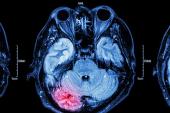Higher Annual TAVI Volumes Linked to Greater Use of Embolic Protection
Reimbursement was thought to figure prominently into US usage patterns but appears to be less of an issue than experience.

Higher TAVI procedure volumes are associated with a greater likelihood of using an embolic protection device, data from more than 500 US hospitals show.
The authors undertook the study expecting to see less use of the devices at centers on the lower end of the TAVI reimbursement spectrum, said Angela Lowenstern, MD (Vanderbilt University Medical Center, Nashville, TN), the study’s lead author.
“In institutions where reimbursement is lower and adding a $3,000 device really could change the plus or minus for an institution on that procedure, it made sense to us that that might be a factor that made a difference in using or not using embolic protection, but it did not. That was a surprise for us,” she told TCTMD.
Lowenstern and her colleagues say some explanations for the association between volume and use may be greater comfort level with TAVI procedures, as well as a longer history of TAVI experience that makes certain centers and operators more likely to add additional complexity and steps to cases. In the context of TAVI’s 20-year history, in which it was initially performed only at experienced centers before rolling out nationwide, the volume link makes a certain amount of sense.
“It’s possible that some of those initial centers that still have very high volume are also the ones who are more likely to uptake the newer technologies and to use those earlier,” she added. “But any procedure has its own inherent risks, and what really needs to be shown is that there's benefit of this extra step of putting a wire and the device into the carotid arteries.”
The study was published online last week in JAMA Cardiology.
Patterns of Embolic Protection Use and Reimbursement
For the study, Lowenstern and colleagues examined data from the Society of Thoracic Surgeons/American College of Cardiology TVT Registry on 84,353 patients (median age 81 years; 55% male; 4.7% Hispanic or Latino) who underwent TAVI at 511 US centers between January 2018 and September 2019.
The median annual TAVI volume among the centers was 83 cases (range 55-134). Reimbursement ranged widely from US $28,000 to more than US $111,000. Teaching hospitals had higher reimbursement rates than nonteaching hospitals (US $47,912 vs US $43,095), with other variations by diagnosis-related group (DRG) codes.
Hospitals in the Northeast, which made up the fewest centers by geographical region (92 of 511 sites) had the highest median reimbursement at US $53,292. Conversely, hospitals located in the South, which made up the most centers by geographical region (204 sites) had the lowest median reimbursement at US $41,816. When embolic protection was used, the researchers found it was more often associated with prior stroke (P = 0.048), female sex (P < 0.001), hemodialysis (P < 0.001), and shock (P = 0.03).
A number of factors are believed to contribute to the overall low rates of embolic protection in TAVI. In Lowenstern’s study, it was used in just 7% of more than 80,000 patients. One may be that the Nationwide Readmissions Database and others have found little evidence that despite capturing debris in nearly all cases, the devices provide clinical benefits in terms of reduction in new brain MRI lesions, stroke, or death. Despite this, the Centers for Medicare & Medicaid Services (CMS) created a new technology add-on payment (NTAP) in 2018 to at least partially reimburse centers for using the Sentinel (Boston Scientific) TAVI cerebral protection device.
Approximately 60% of study participants underwent TAVI after the implementation of the NTAP by CMS. There was no difference in the rate of embolic protection use before versus after the NTAP (P = 0.17). In an analysis of the association of the NTAP with embolic protection by reimbursement tertile (lowest to highest), the slope for both tertiles became less positive after the NTAP became available, which the researchers say suggests that uptake of the device slowed down over time. Lowenstern said that was another surprise.
“I don’t think we can definitely say that it’s related to the NTAP. It's probably more just a factor of longer time on the market, more availability, and perhaps that the initial uptrend in use was starting to level off,” she added.
Welcome Insights
In an accompanying editorial, Neel M. Butala, MD (Beth Israel Deaconess Medical Center, Boston, MA), and colleagues say the study is a welcome look at the drivers of a device with uncertain clinical efficacy while additional data are awaited from the ongoing randomized PROTECTED TAVR trial of Sentinel. That study is randomizing approximately 3,000 patients to cerebral protection with Sentinel during TAVI or to TAVI alone, with the primary endpoint being the rate of any stroke at 72 hours or upon hospital discharge. Results will be released next month at the TCT 2022 meeting.
Butala and colleagues note that among the factors that can impact cerebral embolic protection device selection and use are site-specific availability, technical or training requirements, and patient preference. Importantly, they say Lowenstern and colleagues’ analysis shows the need to carefully evaluate reimbursement policies like the NTAP program.
“If an NTAP encourages the incorporation of a device into the prevailing standard of care, it might be particularly problematic for devices reaching the market prior to the development of robust and generalizable clinical evidence,” they write. “Fortunately, in the case of [embolic protection] for TAVR, the PROTECTED TAVR trial completed enrollment in a rapid fashion, suggesting that the reimbursement incentive created by the NTAP did not adversely affect clinical equipoise for the device.”
More broadly, Butala and colleagues maintain that the experience of Sentinel through the clearance and reimbursement pathway is emblematic of why CMS and the US Food and Drug Administration need to address a “lack of coordination” between the two agencies with regard to approval and coverage determination.
“As the pipeline of innovative cardiovascular devices continues to flourish, future policies that more seamlessly marry these regulatory processes should limit perverse pricing and utilization incentives, create a more-conducive environment for evidence generation, and provide a more predictable reimbursement landscape—all ultimately translating into improved patient access to important new technologies,” they write.
L.A. McKeown is a Senior Medical Journalist for TCTMD, the Section Editor of CV Team Forum, and Senior Medical…
Read Full BioSources
Lowenstern A, Hung A, Manandhar P, et al. Association of transcatheter aortic valve replacement reimbursement, new technology add-on payment, and procedure volumes with embolic protection device use. JAMA Cardiol. 2022;Epub ahead of print.
Butala NM, Oseran AS, Yeh RW. Innovation’s disjointed path from approval to payment—the case of embolic protection devices for transcatheter aortic valve replacement. JAMA Cardiol. 2022;Epub ahead of print.
Disclosures
- Lowenstern reports consulting for Edwards Lifesciences.
- Butala reports no relevant conflicts of interest.





Comments